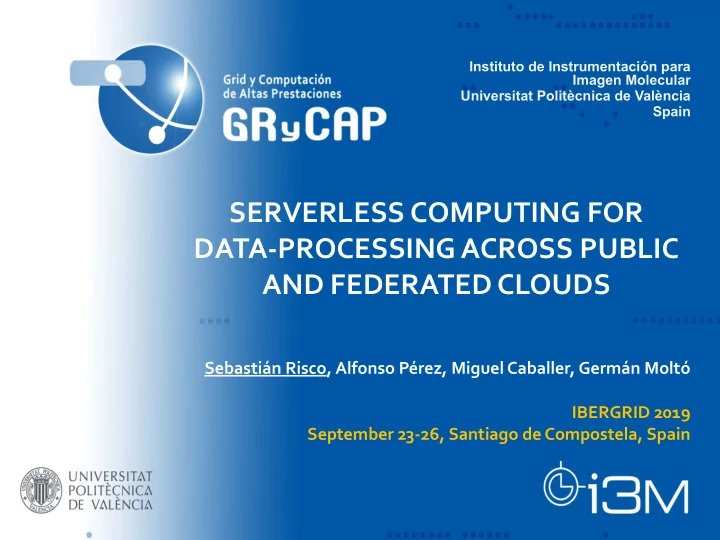

Instituto de Instrumentación para Imagen Molecular Universitat Politècnica de València Spain SERVERLESS COMPUTING FOR DATA-PROCESSING ACROSS PUBLIC AND FEDERATED CLOUDS Sebastián Risco, Alfonso Pérez, Miguel Caballer, Germán Moltó IBERGRID 2019 September 23-26, Santiago de Compostela, Spain
INDEX • Motivation • Goals • Components • Architecture • Use case • Conclusions • Future work 2
MOTIVATION • Public Cloud Serverless services are evolving from the initial FaaS approach to also embrace the execution of containerised applications. • AWS Fargate, Google Cloud Run, AWS Batch. • Scientific applications may require specific resources (large amount of memory or CPUs, accelerated devices, etc). • Private or Federated Clouds not always fulfil the requirements. • Federated storage for data persistence remains suitable for scientific applications. 3
GOALS • Execute hybrid Serverless workloads using public Clouds for computing and federated storage for data persistence. • AWS services to run containerised data-processing applications and EGI DataHub as a storage back-end. • Automatically delegate longer executions, as well as those requiring specialised hardware (GPUs), to AWS Batch. • Demonstrate the feasibility of this approach through a use case in video processing. • GPU-based computing in the public Cloud to dramatically accelerate object recognition. 4
COMPONENTS • AWS Lambda: • Public Functions as a Service (FaaS) platform. • No infrastructure provision or configuration management • Automated elasticity. • Supports Java, Go, PowerShell, Node.js, C#, Python, and Ruby code. • Function limits: 3008 MB Memory and 15 minutes execution timeout. • AWS Batch: • Execute jobs as containerized applications running on Amazon ECS. • Granular job definitions → specify resource requirements, IAM roles, volumes, GPU access, etc. • Dynamic compute resource provisioning and scaling. • No timeout. 5
COMPONENTS • Serverless Container-aware ARchitectures (SCAR): • Run containerised applications on AWS Lambda. • Defines an event-driven file-processing programming model. • Integrated with AWS Batch in order to support long-running jobs and accelerated computing. A. Pérez, G. Moltó, M. Caballer, and A. Calatrava, “Serverless computing for container-based architectures” , Futur. Gener. Comput. Syst. , vol. 83, pp. 50–59, Jun. 2018. https://github.com/grycap/scar 6
COMPONENTS • EGI Data Hub: • Service to make data discoverable and available in an easy way across all EGI federated resources, based on Onedata: • High-performance data management solution that offers unified data access across globally distributed environments and multiple types of underlying storage. • Allows users to share, collaborate and perform computations on the stored data easily. • OneTrigger: • Tool to detect Onedata file events in order to trigger a webhook. • It can run as a Serverless function using AWS Lambda and CloudWatch Events. 7
COMPONENTS • FaaS Supervisor (Core component of SCAR and OSCAR): • Manages input and output. • Handles the execution of the user-defined script. • Loads Docker containers in AWS Lambda environments. • Integrated with Onedata. 8
ARCHITECTURE 9
USE CASE YOLO (You Only Look Once): • Real-time object detection system. • Uses Darknet, an open source neural network framework. • Supports CPU and GPU computation. • Can process images or videos. 10
USE CASE Why is GPU recommended for video processing? • Processing a single image could take few seconds using a CPU. • If we want the result in images: • The video can be split into images. • Images can be quickly processed in parallel functions using a Serverless platform (over CPU). • If we want the result as a video: • It has to be processed as a single job. • OpenMP can be used to accelerate processing in multi-core CPUs → It's still very slow. 11
USE CASE 12
USE CASE • SCAR function definition file Docker image User-defined script Create input bucket in AWS S3 Create HTTP endpoint in AWS API Gateway Enable AWS Batch mode AWS Batch configuration Onedata required environment variables 13
USE CASE • Integration with EGI DataHub (Onedata) 14
USE CASE 15
USE CASE 16
USE CASE 17
USE CASE 18
CONCLUSIONS • Delegating computational jobs to public Cloud providers is convenient for certain cases (even though when private or federated resources are available). • Serverless allows to reduce costs in longer or accelerated executions. • Hybrid workflows enable fully leveraging of cloud capabilities in order to run scientific applications. 19
FUTURE WORK • Support additional storage back-ends. • OneTrigger improvements: • More efficient file upload checking. • Integrate OneTrigger-Lambda with the CLI to automate deployment. • Send events to functions directly (without API Gateway). • Integrate more use cases. • We are accepting contributions at: https://github.com/grycap/scar https://github.com/grycap/faas-supervisor https://github.com/grycap/onetrigger 20
CONTACT & ACKNOWLEDGEMENTS Sebastián Risco - serisgal@i3m.upv.es Alfonso Pérez - alpegon3@upv.es Miguel Caballer - micafer1@upv.es Germán Moltó - gmolto@dsic.upv.es Instituto de Instrumentación para Imagen Molecular Universitat Politècnica de València Camino de Vera s/n 46022, Valencia SPAIN The authors would like to thank the Spanish “Ministerio de Economía, Industria y Competitividad” for the project “BigCLOE” with reference number TIN2016-79951-R. This work has been partially funded through the EGI Strategic & Innovation Fund. 21
Recommend
More recommend